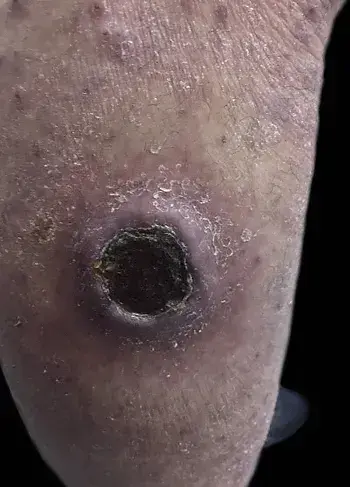What Does Crust Look Like on Wounds?
- mdavis107
- Oct 15, 2020
- 2 min read
Updated: Jul 23
How Crusts Form and Protect Healing Skin
Crusting is one of the most recognizable signs of wound healing. But what exactly is a crust, and what does it mean for recovery?
When the skin is injured—due to cuts, abrasions, or scrapes—the body initiates the clotting process to stop bleeding. A blood clot made of platelets, fibrin, and red blood cells forms at the injury site. As the clot dries, it hardens into a crust (often called a scab), which acts as a temporary shield while the skin regenerates underneath.
This crust is more than just a dry layer—it plays a vital role in wound healing. It:
Prevents infection by blocking bacteria and debris
Maintains moisture in the wound bed to support cell migration
Protects delicate new tissue from further damage
Crusting is a natural part of the wound healing process and typically forms within 24 hours of injury.

What Does a Crust Look Like?
A wound crust is typically:
Rusty brown or dark red in color
Dry and slightly raised from the surrounding skin
Firm to the touch but may soften with moisture exposure
It's often mistaken for a scab, and in casual language, the terms are used interchangeably.

How Long Does a Crust Stay on a Wound?
The crust remains until new skin cells (keratinocytes) have resurfaced the wound. This process may take:
Several days for minor abrasions
Up to a few weeks for larger or deeper wounds
When healing is complete, the crust typically loosens and falls off naturally.

What Happens After the Crust Falls Off?
Once the crust detaches, it reveals newly formed skin underneath—often pink, tender, and more susceptible to injury or sunburn. During this time:
Avoid picking or scrubbing the area
Protect the site with sunscreen or a clean bandage if needed
Continue monitoring for signs of infection or delayed healing

Supporting Providers in Every Stage of Healing
With more than 25 years of experience in wound care and hyperbaric program development, Shared Health Services equips hospitals and physician practices with the tools, coaching, and clinical guidance needed to deliver high-quality, compliant wound care. Whether you're building a new service line or strengthening an existing one, our tailored support empowers your team to improve outcomes and serve patients more effectively—without giving up control.
You Might Also Like:






Comments